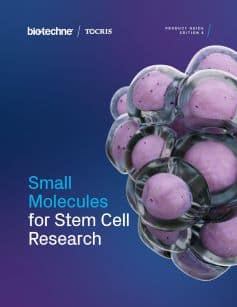γ-Secretase
γ-secretase is a multi-subunit internal protease that cleaves within the transmembrane domain of its substrates. It is an integral membrane protein and minimally consists of four proteins; presenilin, nicastrin, APH-1 and PEN-2. γ-secretase is involved in the processing of Notch.
γ-Secretase Modulators |
|
|---|---|
| Cat. No. | Product Name / Activity |
| 5550 | E 2012 |
| γ-secretase modulator; Notch-sparing | |
γ-Secretase Inhibitors |
|
| Cat. No. | Product Name / Activity |
| 6363 | Avagacestat |
| Highly potent γ-secretase inhibitor; orally bioavailable | |
| 2870 | BMS 299897 |
| Potent γ-secretase inhibitor | |
| 6476 | Compound E |
| γ-secretase inhibitor; induces neuronal differentiation | |
| 2634 | DAPT |
| γ-secretase inhibitor; induces neuronal differentiation; blocks Notch signaling | |
| 4489 | DBZ |
| γ-secretase inhibitor; inhibits Notch pathway | |
| 2627 | L-685,458 |
| Potent and selective γ-secretase inhibitor | |
| 6559 | LY 450139 |
| γ-secretase pseudo-inhibitor | |
| 4000 | MRK 560 |
| γ-secretase inhibitor; attenuates amyloid plaque deposition | |
| 5751 | PF 3084014 hydrobromide |
| Potent γ-secretase inhibitor | |
γ-secretase is a multi-subunit internal protease that cleaves within the transmembrane domain of its substrates. It is an integral membrane protein and minimally consists of four proteins; presenilin, nicastrin, APH-1 and PEN-2. Presenilin is an aspartic protease and the catalytic subunit of the complex.
γ-secretase is involved in the processing of Notch. The Notch receptor is a single transmembrane spanning protein involved in angiogenesis and cell differentiation during embryonic and adult life. Upon ligand binding, the extracellular domain is cleaved by a metalloprotease named TACE. Following this initial cleavage, γ-secretase cleaves within the transmembrane domain of the remaining Notch protein, releasing the intracellular domain (Nβ) into the cytoplasm. Nβ moves to the nucleus where it upregulates transcription of target genes such as Hes1, Hey1 and Hey2. Deficient Notch signaling impairs developmental angiogenesis in the embryo and prevents wound healing in adult tissues.
External sources of pharmacological information for γ-Secretase :
Literature for γ-Secretase
Tocris offers the following scientific literature for γ-Secretase to showcase our products. We invite you to request* your copy today!
*Please note that Tocris will only send literature to established scientific business / institute addresses.
γ-Secretase Gene Data
| Gene | Species | Gene Symbol | Gene Accession No. | Protein Accession No. |
|---|---|---|---|---|
| Presenilin-1 | Human | PSEN1 | NM_000021 | P49768 |
| Mouse | Psen1 | NM_008943 | P49769 | |
| Rat | Psen1 | NM_019163 | P97887 | |
| Presenilin-2 | Human | PSEN2 | NM_000447 | P49810 |
| Mouse | Psen2 | NM_001128605 | Q61144 | |
| Rat | Psen2 | NM_031087 | O88777 | |
| Nicastrin | Human | NCSTN | NM_015331 | Q92542 |
| Mouse | Ncstn | NM_021607 | P57716 | |
| Rat | Ncstn | NM_174864 | Q8CGU6 | |
| APH1A | Human | APH1A | NM_016022 | Q96BI3 |
| Mouse | Aph1a | NM_146104 | Q8BVF7 | |
| Rat | Aph1a | NM_001014255 | Q5PQQ3 | |
| APH1B | Human | APH1B | NM_031301 | Q8WW43 |
| Mouse | Aph1b | NM_177583 | Q8C7N7 | |
| Rat | Aph1b | NM_001047090 | Q0PY50 | |
| PEN-2 | Human | PSENEN | NM_172341 | Q9NZ42 |
| Mouse | Psenen | NM_025498 | Q9CQR7 | |
| Rat | Psenen | NM_001008764 | Q6QI68 | |
| CD147 | Human | BSG | NM_001728 | P35613 |
| Mouse | Bsg | NM_009768 | P18572 |

